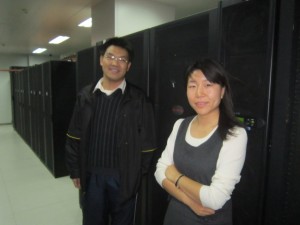BEIJING — When Chinese researchers created the world's first atomic-level simulation of the H1N1 influenza virus, they depended on some heavy computer processing power. Enter the MOLE-8.5, one of China's growing number of world-class supercomputers.
Occupying 150 square meters of basement at Beijing's Institute of Process Engineering,the MOLE-8.5's sleek black cabinets are packed with 2,200 graphics processing chips (GPUs), made by American technology company NVIDIA. Noise generated by the thousands of fans needed to keep the GPUs cool easily drowns out the sound of speech. "The GPUs are faster but also get hotter than [conventional] processors" Dr. Ren Ying, a researcher on the H1N1 simulation project, said.
The MOLE-8.5's processors were able tocreate a computer model of the behavior of each of the 300 million atoms and ions which make up the H1N1 virus, as well as a water-based solution surrounding it, according to a report published earlier this month. H1N1 is the most complex virus yet to be simulated, the researchers say. "No one has done analysis of an entire H1N1 virus on the atomic level before," Ren said.
The simulation helps bridge a gap between previous microscopic studies of the H1N1 virus, and higher level analysis of the virus' life-cycle. "The simulation allows us to closely analyse how the virus reacts to changes in the environment, such as humidity and temperature" Ren said, though she admitted that the simulation simplifies the structure of the virus to some extent.
China's supercomputer capacity has grown rapidly over the last decade, and the country is home to 61 of the world's top 500 supercomputers, second only to the US. China's most powerful computer, the Tianhe-1A, is 1.4 times more powerful than US' fastest machine. The MOLE-8.5 is currently the sixth fastest computer in China, but that may not last long. "We expect to drop down the rankings in future years" Ren said.
Critics have pointed out that Chinese supercomputers rely heavily on GPUs, similar to those found in games consoles and PC graphics cards. Cao Jianwen, a professor at the Chinese Academy of Social Sciences, called the Tianhe-1A a glorified "games machine" in an interview this summer, stating that no software yet exists which can make use of the GPUs in combination with ordinary processors.
But the H1N1 simulation project seems to prove that wrong. "Our software makes use of the GPUs in combination with CPUs," Ren said. "We couldn't find the right software commercially, so we had to write it ourselves."
The simulation project was set up with medical applications in mind, Dr. Ren said"I hope it will help us to understand how the virus reacts under different conditions, and develop new medicines," she said ”We’re looking for research partners who want to make use of our software." She said. "We don't yet have any clear plans for how to use the simulation."

Researchers Dr. Wang Xiaowei and Dr. Ren Ying pictured with the MOLE-8.5 (Image by IPE)
(Sources:SmartPlanet)